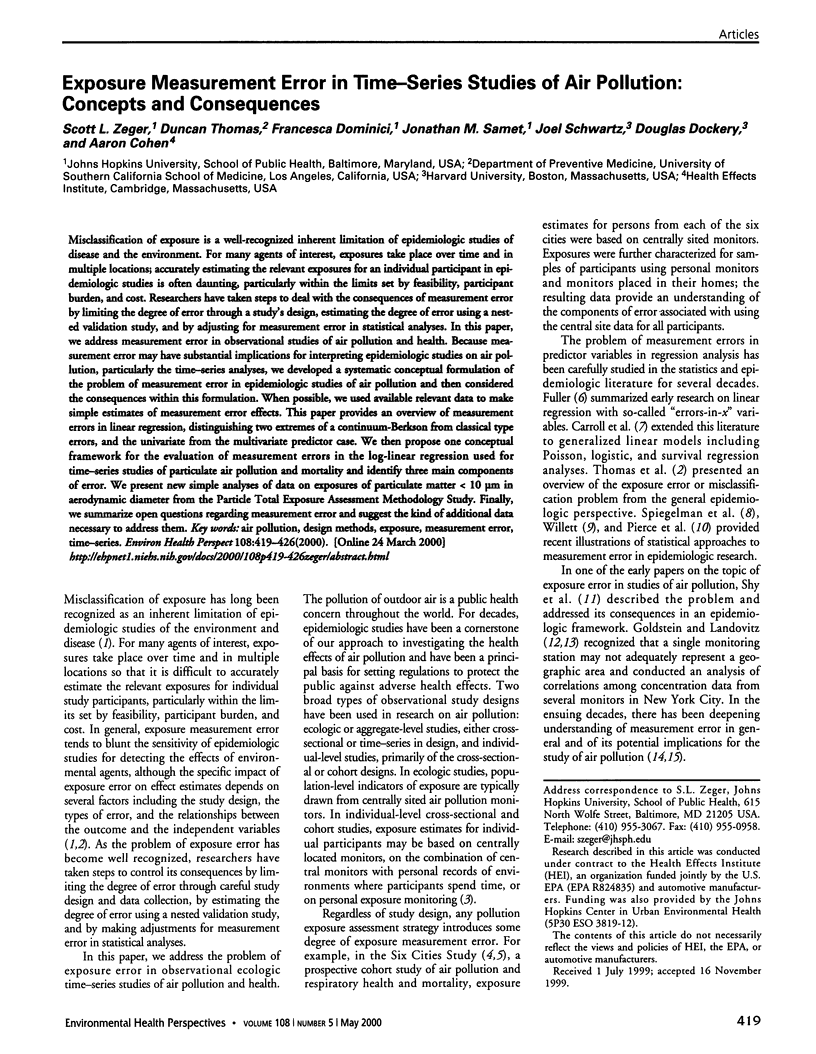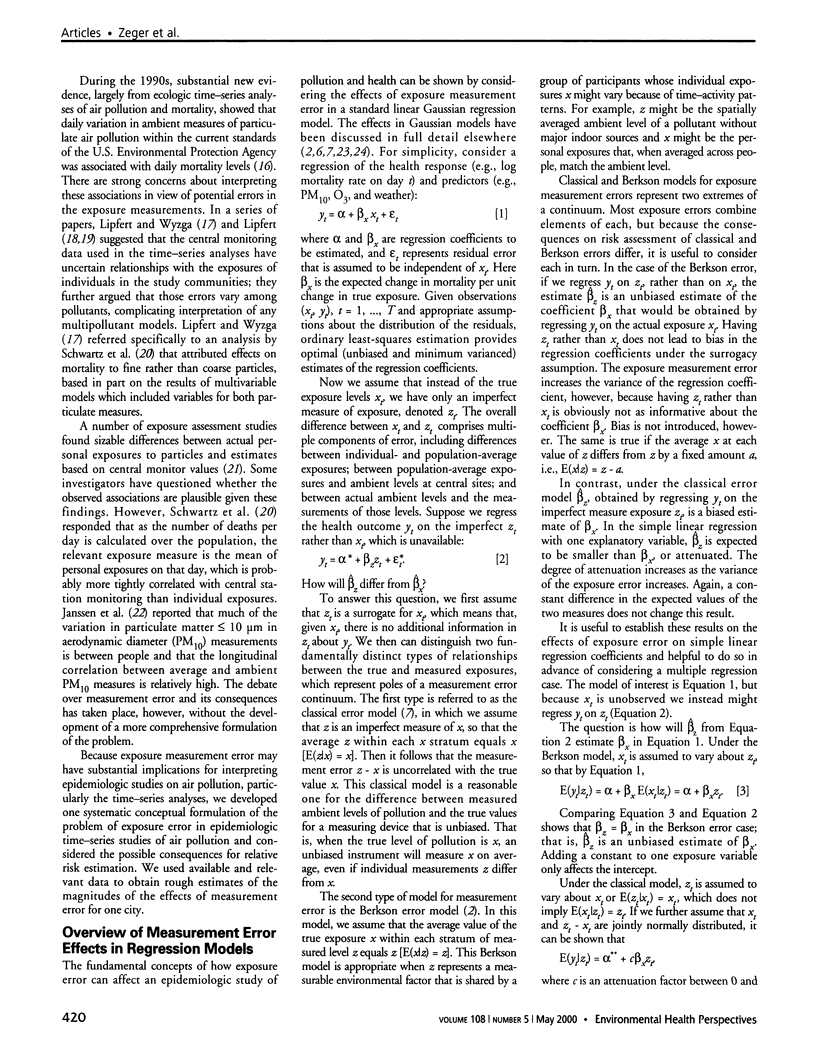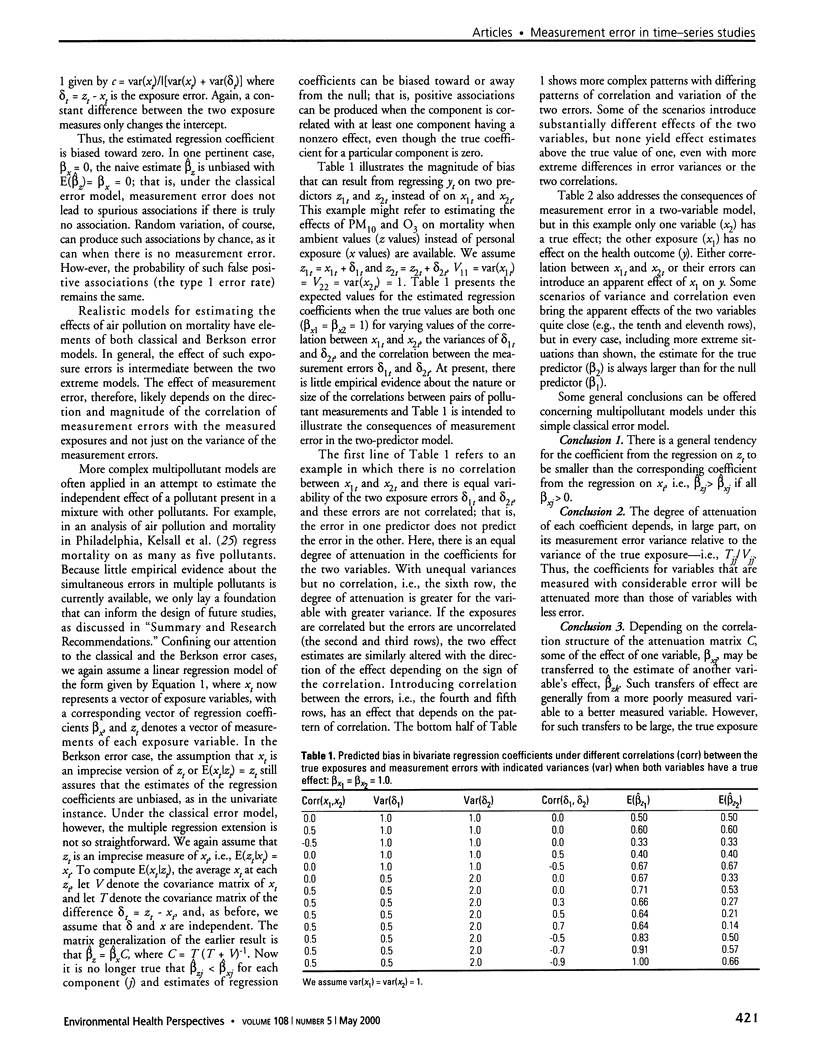Abstract
Misclassification of exposure is a well-recognized inherent limitation of epidemiologic studies of disease and the environment. For many agents of interest, exposures take place over time and in multiple locations; accurately estimating the relevant exposures for an individual participant in epidemiologic studies is often daunting, particularly within the limits set by feasibility, participant burden, and cost. Researchers have taken steps to deal with the consequences of measurement error by limiting the degree of error through a study's design, estimating the degree of error using a nested validation study, and by adjusting for measurement error in statistical analyses. In this paper, we address measurement error in observational studies of air pollution and health. Because measurement error may have substantial implications for interpreting epidemiologic studies on air pollution, particularly the time-series analyses, we developed a systematic conceptual formulation of the problem of measurement error in epidemiologic studies of air pollution and then considered the consequences within this formulation. When possible, we used available relevant data to make simple estimates of measurement error effects. This paper provides an overview of measurement errors in linear regression, distinguishing two extremes of a continuum-Berkson from classical type errors, and the univariate from the multivariate predictor case. We then propose one conceptual framework for the evaluation of measurement errors in the log-linear regression used for time-series studies of particulate air pollution and mortality and identify three main components of error. We present new simple analyses of data on exposures of particulate matter < 10 microm in aerodynamic diameter from the Particle Total Exposure Assessment Methodology Study. Finally, we summarize open questions regarding measurement error and suggest the kind of additional data necessary to address them.
Full text
PDF







Images in this article
Selected References
These references are in PubMed. This may not be the complete list of references from this article.
- Dockery D. W., Pope C. A., 3rd Acute respiratory effects of particulate air pollution. Annu Rev Public Health. 1994;15:107–132. doi: 10.1146/annurev.pu.15.050194.000543. [DOI] [PubMed] [Google Scholar]
- Dockery D. W., Pope C. A., 3rd, Xu X., Spengler J. D., Ware J. H., Fay M. E., Ferris B. G., Jr, Speizer F. E. An association between air pollution and mortality in six U.S. cities. N Engl J Med. 1993 Dec 9;329(24):1753–1759. doi: 10.1056/NEJM199312093292401. [DOI] [PubMed] [Google Scholar]
- Ferris B. G., Jr, Speizer F. E., Spengler J. D., Dockery D., Bishop Y. M., Wolfson M., Humble C. Effects of sulfur oxides and respirable particles on human health. Methodology and demography of populations in study. Am Rev Respir Dis. 1979 Oct;120(4):767–779. doi: 10.1164/arrd.1979.120.4.767. [DOI] [PubMed] [Google Scholar]
- Janssen N. A., Hoek G., Brunekreef B., Harssema H., Mensink I., Zuidhof A. Personal sampling of particles in adults: relation among personal, indoor, and outdoor air concentrations. Am J Epidemiol. 1998 Mar 15;147(6):537–547. doi: 10.1093/oxfordjournals.aje.a009485. [DOI] [PubMed] [Google Scholar]
- Kelsall J. E., Samet J. M., Zeger S. L., Xu J. Air pollution and mortality in Philadelphia, 1974-1988. Am J Epidemiol. 1997 Nov 1;146(9):750–762. doi: 10.1093/oxfordjournals.aje.a009351. [DOI] [PubMed] [Google Scholar]
- Lipfert F. W. Air pollution and human health: perspectives for the '90s and beyond. Risk Anal. 1997 Apr;17(2):137–146. doi: 10.1111/j.1539-6924.1997.tb00853.x. [DOI] [PubMed] [Google Scholar]
- Lipfert F. W., Wyzga R. E. Air pollution and mortality: the implications of uncertainties in regression modeling and exposure measurement. J Air Waste Manag Assoc. 1997 Apr;47(4):517–523. doi: 10.1080/10473289.1997.10464417. [DOI] [PubMed] [Google Scholar]
- Navidi W., Thomas D., Stram D., Peters J. Design and analysis of multilevel analytic studies with applications to a study of air pollution. Environ Health Perspect. 1994 Nov;102 (Suppl 8):25–32. doi: 10.1289/ehp.94102s825. [DOI] [PMC free article] [PubMed] [Google Scholar]
- Ozkaynak H., Xue J., Spengler J., Wallace L., Pellizzari E., Jenkins P. Personal exposure to airborne particles and metals: results from the Particle TEAM study in Riverside, California. J Expo Anal Environ Epidemiol. 1996 Jan-Mar;6(1):57–78. [PubMed] [Google Scholar]
- Pierce D. A., Stram D. O., Vaeth M. Allowing for random errors in radiation dose estimates for the atomic bomb survivor data. Radiat Res. 1990 Sep;123(3):275–284. [PubMed] [Google Scholar]
- Schwartz J., Dockery D. W., Neas L. M. Is daily mortality associated specifically with fine particles? J Air Waste Manag Assoc. 1996 Oct;46(10):927–939. [PubMed] [Google Scholar]
- Spiegelman D., McDermott A., Rosner B. Regression calibration method for correcting measurement-error bias in nutritional epidemiology. Am J Clin Nutr. 1997 Apr;65(4 Suppl):1179S–1186S. doi: 10.1093/ajcn/65.4.1179S. [DOI] [PubMed] [Google Scholar]
- Vedal S. Ambient particles and health: lines that divide. J Air Waste Manag Assoc. 1997 May;47(5):551–581. doi: 10.1080/10473289.1997.10463922. [DOI] [PubMed] [Google Scholar]
- Wallace L. Indoor particles: a review. J Air Waste Manag Assoc. 1996 Feb;46(2):98–126. doi: 10.1080/10473289.1996.10467451. [DOI] [PubMed] [Google Scholar]
- Wilson W. E., Suh H. H. Fine particles and coarse particles: concentration relationships relevant to epidemiologic studies. J Air Waste Manag Assoc. 1997 Dec;47(12):1238–1249. doi: 10.1080/10473289.1997.10464074. [DOI] [PubMed] [Google Scholar]





